
Half Dome is a quartz monzonite batholith at the eastern end of Yosemite Valley in Yosemite National Park, California. It is a well-known rock formation in the park, named for its distinct shape. One side is a sheer face while the other three sides are smooth and round, making it appear like a dome cut in half. It stands at nearly 8,800 feet above sea level and is composed of quartz monzonite, an igneous rock that solidified several thousand feet within the Earth. At its core are the remains of a magma chamber that cooled slowly and crystallized beneath the Earth's surface. The solidified magma chamber was then exposed and cut in half by erosion, therefore leading to the geographic name Half Dome.
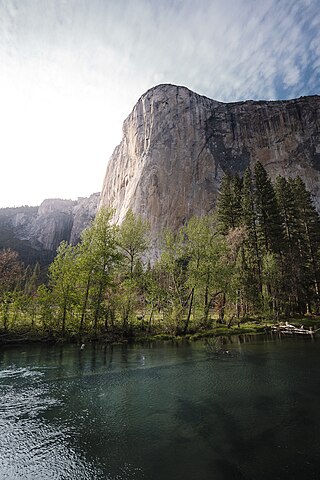
El Capitan is a vertical rock formation in Yosemite National Park, on the north side of Yosemite Valley, near its western end. The granite monolith is about 3,000 feet (914 m) from base to summit along its tallest face and is a world-famous location for big wall climbing, including the disciplines of aid climbing, free climbing, and more recently for free solo climbing.

Camp 4 is a tent-only campground in Yosemite National Park in the United States. It became notable after World War II as "a birthplace of rock climbing’s modern age." It is located at an elevation of 4000 ft on the north side of the Yosemite Valley, close to base of granite cliffs near Yosemite Falls.
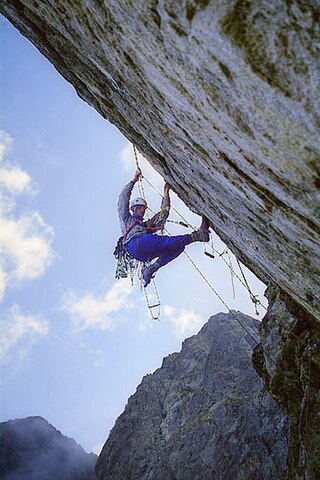
Aid climbing is a form of rock climbing that uses mechanical devices and equipment, such as aiders, for upward momentum. Aid climbing is contrasted with free climbing, which only uses mechanical equipment for protection, but not to assist in upward momentum. Aid climbing can involve hammering in permanent pitons and bolts, into which the aiders are clipped, but there is also 'clean aid climbing' which avoids any hammering, and only uses removable placements.
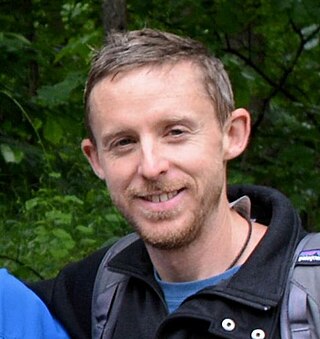
Tommy Caldwell is an American rock climber who has set records in sport climbing, traditional climbing, and in big-wall climbing. Caldwell made the first free ascents of several major routes on El Capitan in Yosemite National Park.

Royal Robbins was one of the pioneers of American rock climbing. After learning to climb at Tahquitz Rock, he went on to make first ascents of many big wall routes in Yosemite. As an early proponent of boltless, pitonless clean climbing, he, along with Yvon Chouinard, was instrumental in changing the climbing culture of the late 1960s and early 1970s by encouraging the use and preservation of the natural features of the rock. He went on to become a well-known kayaker.

Jim Bridwell was an American rock climber and mountaineer, active from 1965 in Yosemite Valley, but later in Patagonia and Alaska. He was noted for pushing the standards of both aid climbing and big wall climbing, and later alpine climbing. He wrote numerous articles on climbing and developed several important pieces of aid climbing equipment. Bridwell was an apprentice to Royal Robbins and Warren Harding, and later the unofficial leader of the Stonemasters.

Ron Kauk is an American rock climber. Kauk is associated with Camp 4 in Yosemite Valley, where he lived for decades, now a resident of El Portal, California.
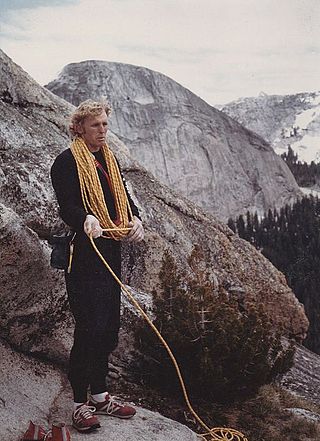
John Bachar was an American rock climber. Noted for his skill at free soloing, he ultimately died during a free solo climb. A fitness fanatic, he was the creator of the climbing training device known as the Bachar ladder.
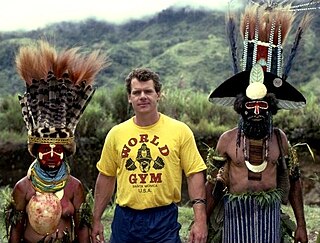
John Long is an American rock climber and author. His stories have been translated into many languages.

In the history of rock climbing, the three main sub-disciplines – bouldering, single-pitch climbing, and big wall climbing – can trace their origins to late 19th-century Europe. Bouldering started in Fontainebleau, and was advanced by Pierre Allain in the 1930s, and John Gill in the 1950s. Big wall climbing started in the Dolomites, and was spread across the Alps in the 1930s by climbers such as Emilio Comici and Riccardo Cassin, and in the 1950s by Walter Bonatti, before reaching Yosemite where it was led in the 1950s to 1970s by climbers such as Royal Robbins. Single-pitch climbing started pre-1900 in both the Lake District and in Saxony, and by the late-1970s had spread widely with climbers such as Ron Fawcett (Britain), Bernd Arnold (Germany), Patrick Berhault (France), Ron Kauk and John Bachar (USA).
Beth Rodden is an American rock climber known for her ascents of hard single-pitch traditional climbing routes. She was the youngest woman to climb 5.14a (8b+) and is one of the only women in the world to have redpointed a 5.14c (8c+) traditional climbing graded climb. Rodden and fellow climber Tommy Caldwell were partners from 2000 to 2010, during which time they completed the second free ascent of The Nose. In 2008, Rodden made the first ascent of Meltdown, one of the hardest traditional climbs in the world and the first time in history that a female climber matched the peak of the highest climbing grades.

The Nose is a big wall climbing route up El Capitan. Once considered impossible to climb, El Capitan is now the standard for big wall climbing. It is recognized in the historic climbing text Fifty Classic Climbs of North America and considered a classic around the world.
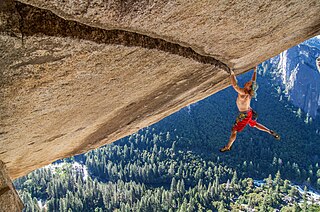
Separate Reality is a 66-foot (20 m) traditional climbing route in Yosemite National Park in California. The route is known for its exposed and dramatic crux that consists of a 20-foot (6.1 m) long crack in its horizontal roof. When it was first free-climbed by Ron Kauk in 1978, it was one of the first climbs in the world to have a grade of 7a+ (5.12a). In 1986, German climber Wolfgang Güllich free soloed the route, and the photographs by Austrian Heinz Zak became iconic in rock climbing history.

Charles Marshall Pratt was an American rock climber known for big wall climbing first ascents in Yosemite Valley. He was also a long-time climbing instructor and mountain guide with Exum Mountain Guides in the Grand Tetons.
Tobin Sorenson was an American rock climber and alpinist famed for establishing bold first ascents on Yosemite big walls, in the Alps, Canadian Rockies, and New Zealand.

Sender Films is an American film production company based in Boulder, Colorado. Productions include outdoor adventure films, television shows, and commercials.

Midnight Lightning is a 7.62-metre (25.0 ft) high granite bouldering route on the Columbia Boulder in Camp 4 of Yosemite National Park. When first solved in May 1978 by American rock climber Ron Kauk, it was graded at V8 (7B/7B+), which was the world's second-ever boulder route at that grade, and the first in North America. Even today, the route is still considered a "hard" V8 grade. Midnight Lightning is the most notable bouldering route in climbing along with Dreamtime, and its ascent is considered an important moment in the history and the development of bouldering as a sport in its own right.

Kevin Jorgeson is an American rock climber. In 2015, with Tommy Caldwell, he successfully completed the first-ever free climb of The Dawn Wall on the southeast face of El Capitan in Yosemite National Park.
Hayden Kennedy was an American rock climber and mountaineer who made difficult ascents in North America, Patagonia and in the Himalaya. He died by suicide in 2017 after the sudden death of his partner. He was the son of renowned writer and mountaineer Michael Kennedy and he won the Piolet d'Or for his ascent of The Ogre in 2013, and for Light Before Wisdom in 2016.

















